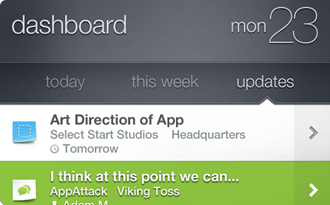Some of the recent activity at the 37signals Product Blog:
 Case studies
Case studies
Tim Ferriss explains how his new book “The 4-Hour Body” came to life with Basecamp and Highrise (“Right away, it made things 10 times easier.”). He details how he uses tags in Highrise:
- “.tim” – I use this to indicate people or companies I have strong connections with. They’re usually close friends of mine.
- “@California”, “@NewYork”, etc. – Used to show where a person or company is located.
- “company-in-book” – There are a ton of companies in “The 4-Hour Body.” We wanted to be sure we had them all listed out somewhere so we could easily reach out and open the door to help with the launch / give them free copies of the book.
- “facebook”, “twitter”, and “youtube” – Some of our Highrise contacts have enormous followings online and have offered to help through their strongest channels.
- “newsletter” – These are friends of mine with big email newsletters who had indicated interest in mailing to their lists.
- “promotion” – Sometimes people and companies email me, saying they want to help promote the book. This tag helps us keep track of everyone who has committed to doing a promotion around the launch date.
Elliot Jay Stocks is a designer, illustrator, author, and the creator of 8 Faces magazine. He says, “Without Basecamp, the whole project would have descended into chaos.”
The creative process of the magazine is basically about having to do a bit of everything at once, so that means having individual to-do lists for areas like ‘production’ (liaising with the printers and distributors), ‘editorial’ (organising transcriptions, commissioning articles, editing copy), ‘partnerships’ (obtaining ad creatives, chasing invoices), ‘website’ (commissioning the design, logging bugs, requesting new features from the developers), and ‘art & design’.
Highrise seals deals for WebGreek — a tool that aims to help Greek organizations manage their chapters online — by “building a rolodex of friendships, not just clients.” CEO Patrick Allen explains how the company builds detailed personas for every one of its potential partners.
Dynamic Language is a Seattle-based localization, translation, and interpretation services provider that works in more than 150 languages and uses Basecamp and Highrise. Among other uses, the company links the Basecamp API to its internal database.
We have a custom internal database application that handles Accounts Receivable, Accounts Payable, Payroll and more, and we’ve been able to use the Basecamp API to link our internal database bi-directionally with Basecamp. Whether a task is marked as complete on the Basecamp side, or internally, it’s immediately reflected on both systems. Our developer has been extremely impressed with how reliable and useful this interface has been, and we keep finding new ways to use the API.
 Ticket River will print and process over 40 million tickets this year. Lance Trebesch (left) explains how the company organizes 25 employees, stretched across 3 continents and 6 locations, with Basecamp.
Ticket River will print and process over 40 million tickets this year. Lance Trebesch (left) explains how the company organizes 25 employees, stretched across 3 continents and 6 locations, with Basecamp.
Extras
RightSignature is a tool that enables you to obtain legally-binding, handdrawn electronic signatures from your customers in minutes. And it now integrates with Highrise so you can access your Highrise contact list from inside RightSignature.

Headquarters is a third-party iPhone app for Basecamp. It combines the ability to manage projects in Basecamp with the feel of a Get Things Done app. According to the developers at Select Start, it’s designed “from the ground up around productivity, relevance, and ease of use.”

Sparks and Torch are a couple of third-party Campfire apps for iPad.
SnapEngage is a proactive live chat tool that integrates with Highrise and Basecamp. For example, it les you store all your live chat and offline conversations directly in Highrise.
Subscribe to the Product Blog RSS feed.

This discussion is closed.